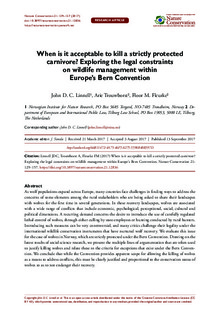| dc.contributor.author | Linnell, John Durrus | |
| dc.contributor.author | Trouwborst, Arie | |
| dc.contributor.author | Fleurke, Floor M. | |
| dc.coverage.spatial | Norway | nb_NO |
| dc.date.accessioned | 2017-09-22T11:50:16Z | |
| dc.date.available | 2017-09-22T11:50:16Z | |
| dc.date.created | 2017-09-14T10:29:10Z | |
| dc.date.issued | 2017 | |
| dc.identifier.citation | Nature Conservation. 2017, 21 129-157. | nb_NO |
| dc.identifier.issn | 1314-6947 | |
| dc.identifier.uri | http://hdl.handle.net/11250/2456277 | |
| dc.description.abstract | As wolf populations expand across Europe, many countries face challenges in finding ways to address the concerns of some elements among the rural stakeholders who are being asked to share their landscapes with wolves for the first time in several generations. In these recovery landscapes, wolves are associated with a wide range of conflicts that include economic, psychological, perceptional, social, cultural and political dimensions. A recurring demand concerns the desire to introduce the use of carefully regulated lethal control of wolves, through either culling by state employees or hunting conducted by rural hunters. Introducing such measures can be very controversial, and many critics challenge their legality under the international wildlife conservation instruments that have nurtured wolf recovery. We evaluate this issue for the case of wolves in Norway, which are strictly protected under the Bern Convention. Drawing on the latest results of social science research, we present the multiple lines of argumentation that are often used to justify killing wolves and relate these to the criteria for exceptions that exist under the Bern Convention. We conclude that while the Convention provides apparent scope for allowing the killing of wolves as a means to address conflicts, this must be clearly justified and proportional to the conservation status of wolves so as to not endanger their recovery. | nb_NO |
| dc.language.iso | eng | nb_NO |
| dc.rights | Navngivelse 4.0 Internasjonal | * |
| dc.rights.uri | http://creativecommons.org/licenses/by/4.0/deed.no | * |
| dc.title | When is it acceptable to kill a strictly protected carnivore? Exploring the legal constraints on wildlife management within Europe’s Bern Convention | nb_NO |
| dc.type | Journal article | nb_NO |
| dc.type | Peer reviewed | nb_NO |
| dc.description.version | publishedVersion | nb_NO |
| dc.subject.nsi | VDP::Zoologiske og botaniske fag: 480 | nb_NO |
| dc.subject.nsi | VDP::Zoology and botany: 480 | nb_NO |
| dc.source.pagenumber | 129-157 | nb_NO |
| dc.source.volume | 21 | nb_NO |
| dc.source.journal | Nature Conservation | nb_NO |
| dc.identifier.doi | 10.3897/natureconservation.21.12836 | |
| dc.identifier.cristin | 1493645 | |
| dc.relation.project | Norges forskningsråd: 251112 | nb_NO |
| cristin.unitcode | 7511,2,0,0 | |
| cristin.unitname | Avdeling for terrestrisk økologi | |
| cristin.ispublished | true | |
| cristin.fulltext | original | |
| cristin.qualitycode | 1 | |

